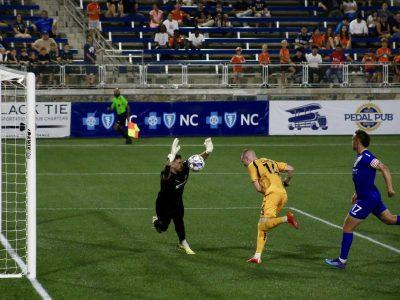by Jeff Laughlin. Photos by Jennifer Laughlin.
The holidays found the High Point University campus eerily quiet. The seasonal changes had taken their toll on the gorgeous campus. Trees had lost the last of their leaves, and brown patches of grass now outnumbered the green. Usually, the fountain runs and the campus swirls with students, but Thanksgiving break kept the kids away.
One spot still hummed, though. Shoes squeaked against a gymnasium floor in layup lines while parents and fans milled about the Millis Athletic Center. Thanksgiving ended a little early for the HPU Women’s Basketball Team. The Panthers started the season 2-3, not the beginning High Point had envisioned after their successes last year.
In 2013, the Panthers bought into the up-tempo style introduced by Head Coach DeUnna Hendrix. That year they won the most conference games in their history and played in the National Invitational Tournament .
Hendrix liked what she saw in recent losses. In a close one to NC State, Hendrix told someone for the school’s website: “I am really proud of our effort tonight and I really feel like we are on the way to becoming a much tougher team. We aren’t good enough to have mental lapses on the defensive end so we need to get better there.”
High Point spent the entire game playing from behind to lose by four points. In a similar game, the Panthers beat the College of William and Mary in overtime while coming back from a 12-point deficit. That’s the kind of game — a gritty comeback — that defines a team in the beginning of the year. To follow it up with a 14-point loss to Davidson could have been equally defining.
The pre-holiday life of teams from small Division I universities usually looks like this. Teams can come in from rough early-season schedules and still be favorites to win the conference. While ACC and Big 10 teams tee off on smaller conference opponents as warm-ups for their big games, someone has to be that smaller team.
 High Point’s early struggles don’t define them, and neither does their win-loss record. Last year’s regular-season Big South conference championship still came with 11 losses, a cluster of them toward the beginning of the season to ACC and Southern Conference teams.
High Point’s early struggles don’t define them, and neither does their win-loss record. Last year’s regular-season Big South conference championship still came with 11 losses, a cluster of them toward the beginning of the season to ACC and Southern Conference teams.
What teams like High Point learn from the holiday stretch fuels the most important part of the season, so coming into a game against Elon University on Nov. 30, Coach Hendrix had a lot to measure. How would her team bounce back from a rough stretch? How can she define her team when it is time to delineate their roles once the conference schedule begins?
Those questions highlight Hendrix’s coaching style. She runs a system based on quick shots and tenacious defense. Many times over, she will tell reporters that High Point is not a “half-court team.” Hendrix does not mean that her team cannot run a set play or learn how to get open. That does not mean they won’t run a pick-and-roll or give-and-go. They will and they do. They just prefer not to.
“We want to play fast and score in the first 12 seconds of the shot clock if we can,” Hendrix said in post-game press huddle. “We want to be able to say, at the end of the game, we outlasted our opponents and know that they’re leaving dead tired because of the pace of the game. Our point guard will set the tempo and our wings and posts will be running the court furiously with her.”
Instead, they rely on a deep rotation of bench players, a constant barrage of substitutions and, above all else, their legs.
The Panthers run. Oh, how they run. They want shots up within 12 seconds, even if leading down the stretch. They want rebounders to look up immediately, as if throwing outlet passes on instinct rather than knowledge. If Hendrix had it her way, her guards would never pass backwards.
Their practice sessions rely on filling lanes as soon as a ball is rebounded or stolen. On occasion, the Panthers will be running before they even secure a possession. Though it may irk the coaches, they know the downside of their high-octane offense. Maximizing offensive possessions will sometimes come at the cost of defensive maneuvering.
Opponents score. How teams deal with those scores defines their on-court personalities. High Point strives to define themselves by scoring immediately after you.
Call it making the best of a bad situation. The Panthers, on numerous occasions Sunday against Elon, got beat on defensive rotation and immediately recalled their training. Guards would rapidly take the in-bounds pass and fly up the court at near reckless speeds, searching for the best immediate answer.
Like “Jeopardy” contestants who start pressing their buzzers as soon as the question begins, High Point charges ahead toward the basket — any sliver of daylight could be the answer.
Behind the 12-seconds-or-less offense hides a persistent, workmanlike defense. High Point littered their roster with unique individual defenders who, despite a multitude of foul calls in the Elon game, looked poised when attacking off of screens or dealing with low-post moves.
“We constantly change things up on the defensive end,” Hendrix said. “We play at a high intensity so foul trouble is a concern which is why we rely on zone defense more so than we otherwise would.”
 They began the game in a 2-3 zone, trapping at the top of the key when ballhandlers looked timid. High Point denied the ball down low for the most part and stayed on the ground when tempted with fakes. Elon’s best success came in one-on-one matchups on the wing where High Point allowed penetration. When the Panthers’ zone collapsed, Elon had open shooters all over the floor.
They began the game in a 2-3 zone, trapping at the top of the key when ballhandlers looked timid. High Point denied the ball down low for the most part and stayed on the ground when tempted with fakes. Elon’s best success came in one-on-one matchups on the wing where High Point allowed penetration. When the Panthers’ zone collapsed, Elon had open shooters all over the floor.
The zone, as an aesthetic product, is like a line graph. Both can be effective and simple — getting the point across as the lowest common denominator. But laid bare, a line graph usually tells very little of the story. You get a few numbers and maybe a flashy color or two, but information can easily be picked apart with fluid numbers.
The zone, especially in High Point’s case, had the same problem. Once Elon picked it apart after a couple of early turnovers, High Point needed a more fluid, structure-less defense.
The Panthers switched to a straight up woman-to-woman in the second half, and everything changed.
In fact, judging the Panthers by any statistical measure from the first half would be foolish. The team had exceeded the limit of fouls in the first 10 minutes. They shot just 35 percent from the field and had taken very few threes. They were outrebounded. They fouled 12 times, though some were suspect calls. They had just 33 points and trailed by 6. Had Elon hit their free throws, High Point’s half would have been downright dreadful.
The High Point guardplay on offense was especially distressing in the first half. The guard rotation went 4-17 from the floor and had a combined five turnovers. The team missed shot after shot and fell behind — much like they had in their first few games this season.
The offense looked lost at times, going for multiple four-minute stretches without a basket, and the defense allowed separate runs of 8-0 and 7-0.
***
Despite her team’s struggles, Coach Hendrix did not pace the sidelines or gripe with players and referees. She calmly shouted instructions where necessary, but mostly watched the plays unfold. Her hands loosely joined behind her back for much of the game, she would only get really animated during an especially egregious error on defense or when she wanted the team to push the pace even more impossibly than they already had.
Hendrix’s team emulated her poise. Even during the long scoreless streaks, the Panthers would exhale, check the scoreboard and start talking to one another. They barked out defensive assignments in the first-half zone and called plays when the circumstances of the game subjugated them to half-court sets.
High Point played like the score read 0-0. Every possession looked new and integral. During timeouts, the coaches would confer, leaving the players to think and address each other. Once they came together, the team would listen intently and begin shifting their assignments on the court.
They knew where to go, when to switch (seemingly never). They played like a scouting report looks.
 No matter the sport, you can see a well-coached team when the talent leaves them. They still rotate to the open floor; they still keep their hands in passing lanes. Their shots don’t fall, they may get beaten on a play or they may be down, but they methodically hit their stride the same way every time.
No matter the sport, you can see a well-coached team when the talent leaves them. They still rotate to the open floor; they still keep their hands in passing lanes. Their shots don’t fall, they may get beaten on a play or they may be down, but they methodically hit their stride the same way every time.
Rarely will a team like High Point droop their shoulders or pout after a tough play. When shots weren’t falling and the fouls mounted up, the team looked to the sideline. While most teams may see a red-faced maniac screaming about defensive assignments, High Point saw five fingers in the air.
A good basketball team can play like actors. No matter how badly the line before was botched, you can still wow everyone with the next one. The Panthers second-half act depended solely on forgetting the one before it.
No one forgot like guard Kaylah Keys.
Keys’ abysmal shooting in the first half (2-9, 1-4 from three) could have easily wrecked her concentration. The holiday hangover could have claimed her as a victim. She persevered, sparking the initial run to keep High Point afloat.
The Big South picked Keys as preseason player of the year for a reason. Her explosiveness on the break fits the team’s mold — high energy on every play and get to the rack in transition at all costs. She sets herself apart with her ability to get open, hit threes and continually pester ballhandlers on defense.
You’ll hear scouts and talking heads blather about “nose for the ball” and all that nonsense, but it really means that the truly good players distinguish themselves by knowing how to affect plays when they do not have to be — or even need to be —involved.
In a way, Keys magnifies the kind of player Hendrix wants in a recruit: She’s tough, has zero memory of the last shot she took and wants the ball in her hands whenever possible.
“The recruiting philosophy will always stay the same: Find kids who know how to work, are tough-nosed and that are humble enough to want to make an impact while putting the team first,” Hendrix said. “Xs and Os can always be changed based on strengths and weaknesses, but the type of player will be consistent.”
In fact, each of her players embodied a different need as they entered the game — especially in the second half.
Stacia Robertson, who is 6’2”, played a beautiful high-post game, getting to the free-throw line (8-9 for the game) and generally drawing defenders away from the basket so the guards could use the lane. DeAnneisha Jackson’s line — 17 points, 13 rebounds, three blocks and only one turnover — speaks to her contribution as well as description of her tenacious rebounding or back-to-the-basket game.
The guards served as the motor for the Panthers. Aside from Keys, who took a bulk of the shots, Ashante Richard ran the half-court offense when necessary. She recorded a small stat line with three points and four assists, but played good individual defense and only two turnovers in 32 minutes. Maja Michalska hit two huge threes — both in answer to threes Elon had hit on previous possessions — and continually disrupted the perimeter on defense.
The fact that each of her players contributed in their unique way defined the new era of High Point Women’s Basketball. Where once Liberty stood for tyranny in the conference, now there are two roads to the NCAA tournament. As Elon learned in the second half on Sunday, the road less traveled might be the most perilous.
μ μ μ
Coach Hendrix looked giddy as she sat on the trainer’s table.
“My feet are killing me,” she exclaimed.
Keys scoffed nearby, “Oh, your feet are killing you huh?” Keys had just stroked a three to seal the game, an 87-71 victory. The shot looked ill-advised and unnecessary, but neither woman felt like addressing it just then. They were all smiles, and the joke at Hendrix’s expense did not go unnoticed.
Hendrix and Keys laughed and breezed through the pair of interviews about the victory — Hendrix pointing all praise to the players as coaches are wont to do. Then she smirked as she explained her defensive strategy.
“Our kids lost shooters in the zone. I had to challenge them. We went straight five, man-to-man and tested [Elon].” Hendrix looked a bit less giddy, like it hurt to admit her kids had been off-kilter in the zone. The smile returned when she talked about Keys.
“There’s not a bad shot she takes. I’ve said that before. Not one.”
Keys agreed, though not directly. When asked about her final three-pointer, the unnecessary dagger, Keys beamed confidently and said, “Coach told us to keep shooting, keep scoring. So I did.”
 Of course in the moment, Hendrix leaned to her side as if to will the ball into the hoop. And Keys shot her coach a look of near-apology as if to say, “It was there so I had to.” No one ever uttered an apology or chastisement, so the looks they gave each other reverberated between them and them alone. It was just one of those moments between coach and prodigy, an agreement between friends.
Of course in the moment, Hendrix leaned to her side as if to will the ball into the hoop. And Keys shot her coach a look of near-apology as if to say, “It was there so I had to.” No one ever uttered an apology or chastisement, so the looks they gave each other reverberated between them and them alone. It was just one of those moments between coach and prodigy, an agreement between friends.
The parking lots swelled with returning students, leaving their families for the coming nightmare of exams. Even while they study, the pounding of the ball will echo in the gym. Moments of pure clarity and confusion will be born as High Point prepares for conference play. Either way, the coach knows what she has now and the players know what to do. They must grow tougher as the games go along, executing each plan as perfectly as they can until the season changes again.
The Panthers play their next home game, against Presbyterian, this Saturday, Dec. 6, at 2 p.m. On Dec. 8, they host UNCG at 7 p.m., the last home game of 2014. Visit highpointpanthers.com for more information.
Join the First Amendment Society, a membership that goes directly to funding TCB‘s newsroom.
We believe that reporting can save the world.
The TCB First Amendment Society recognizes the vital role of a free, unfettered press with a bundling of local experiences designed to build community, and unique engagements with our newsroom that will help you understand, and shape, local journalism’s critical role in uplifting the people in our cities.
All revenue goes directly into the newsroom as reporters’ salaries and freelance commissions.






Leave a Reply